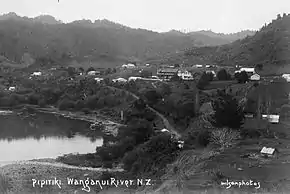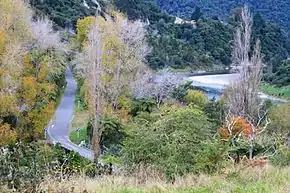Pipiriki
Pipiriki is a settlement in New Zealand, on the east bank of the Whanganui River, due west of the town of Raetihi and 79 kilometres (49 mi) upriver from Whanganui; it was originally on the opposite bank.[1] It is the location of the Paraweka Marae of the hapū Ngāti Kurawhatia of the iwi Te Āti Haunui-a-Pāpārangi.[2]


In the 1840s Pipiriki was a large stockaded settlement, the second largest on the Whanganui River, consisting of eight pā with a total population of 250–300.[3] Wheat was a major crop from 1848 onward, and the water-powered Kaukore flour mill was built in 1854.[1] In 1865 three redoubts across the river were besieged for several weeks by Pai Mārire warriors.[1]
Pipiriki was an important part of the riverboat trade in the 1890s–1920s, marking a major stop for paddle steamers making the 11-hour journey from Whanganui.[4]
There are four marae in the Pipiriki area affiliated with local iwi and hapū:
- Kirikiriroa Marae and Kirikiriroa meeting house are affiliated with the Ngāti Hāua hapū of Ngāti Ruru.
- Paraweka Marae and Pire Kiore meeting house are affiliated with Ngāti Kurawhatia.
- Te Poti Marae and Te Koanga Rehua meeting house and affiliated with Ngāti Tūhoro.
- Tawhata Marae and Te Hinau meeting house are affiliated with Ngāti Rangitengaue, Ngāti Tū, and the Ngāti Hāua hapū of Ngāti Rangitengaue and Ngāti Tū.[5][6]
Notable people
- Andy Anderson, riverboat skipper
- Hōri Pukehika, tribal leader and carver, was born at Pipiriki in 1851
- Rumatiki Ruth Wright, Māori welfare officer and community leader
References
- Beaglehole, Diana (20 March 2014). "Whanganui places: River Settlements". Te Ara: The Encyclopedia of New Zealand. Retrieved 17 November 2015.
- "Paraweka". Maori Maps. Archived from the original on 18 November 2015. Retrieved 18 November 2015.
- Walton, A. (1994). "Settlement Patterns in the Whanganui River Valley, 1839–1864" (PDF). New Zealand Journal of Archaeology. 16: 123–168.
- "The Wanganui River". The Wanganui Herald. 21 December 1891. p. 2. Retrieved 18 November 2015.
- "Te Kāhui Māngai directory". tkm.govt.nz. Te Puni Kōkiri.
- "Māori Maps". maorimaps.com. Te Potiki National Trust.